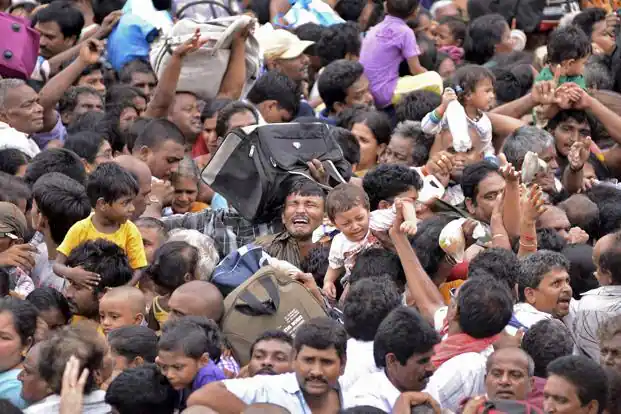BENGALURU: A sudden movement towards the exit, stage, or celebrity can trigger a massive stampede.
STAMPEDE/CROWD CRUSH:
Stampede is of Mexican Spanish origin meaning “uproar” (estampida). It refers to a sudden headlong rush or flight of a herd of large animals in the same direction in a vast open space, usually due to panic or excitement. A human stampede or crowd collapses-crushes occur when there is a sudden movement in any direction in a dangerously large or dense crowd. The main difference is that stampede occurs in an open space whereas in a crowd crush occurs in confined spaces with nowhere to go.
A PREDICTABLE TRAGEDY:
A standing adult occupies 0.18 square meters (2 sq ft) of ground space. At densities of one to two per square meter (0.1 to 0.2/sq ft), individuals can move freely without contact and avoid obstacles and falls. At densities of five per square meter, it becomes difficult for individuals to move, and at higher densities, individuals become pressed against each other. Crowd density rather than crowd size is the critical factor. The difference in movement speed and pressure from the back of the crowd to the front can be catastrophic. In densely packed crowds, individuals get crushed and asphyxiated and one person collapsing often leads to a domino effect with the crowd collapsing on itself. Crowd behaviour can be irrational. Often people seek the experience of an excited noisy densely packed crowd dancing and celebrating at a music concert, sports, religious, political, or celebrity event leading to a crowd crush. A sudden movement towards the exit, stage, or celebrity can trigger a massive stampede.
A FREQUENT TRAGEDY:
Ease of mass transportation globally and mass mobilization by social media have increased the frequency of these tragedies worldwide. Major examples of crushes include the Hillsborough disaster in Sheffield, South Yorkshire, England in 1989, the Love Parade disaster in Duisburg, Germany in 2010, the reported death of over 2,400 people at the Hajj in 2015 at Mina in Mecca, Saudi Arabia, and the Itaewon Halloween crowd crush in Seoul, South Korea in 2022. The Hathras tragedy on 2 July 2024 is the latest example of a massive crowd surging
THE TRAGIC CONSEQUENCES:
In these tragedies, the most common cause of death is asphyxiation (lack of oxygen, inability to breathe), caused either by people crushed together while standing or lying on the ground as people fall on top of one another or pushed against an unyielding barrier. Victims may also have trampling injuries to their vital organs and sustain fractures.
AN AVOIDABLE TRAGEDY:
Poor planning, venue design, crowd control, and mismanagement are the root causes of these tragedies which can be avoided by:
1. Considering the expected crowd size, a suitable flat surfaced well-ventilated, and brightly lit venue, with multiple exits and no nearby obstruction or source of pollution, should be chosen.
2. Precautions against fire, flooding, stage or seating collapse, and terrorist threats are essential.
3. Efficient crowd management includes preventing entry of more than permissible numbers and ensuring even spread of the crowd, clear procedures announced repeatedly for orderly evacuation as done in aircraft and buildings in earthquake-prone areas. Orderly speedy evacuation from buildings, stadiums, ships, trains, and buses is vital. Drones and loudspeakers can be used to watch and direct crowds. Monitoring social media in the area is important to avoid false messages that may incite the crowd or cause panic.
4. Avoid noisy fireworks; throwing freebies or other attractions into the crowd; celebrity announcements or dramatics that may unduly excite the crowd or cause panic. Some events are avoidable such as Doorbuster sales.
5. Organise adequate medical, firefighting, and evacuation facilities for emergencies.
6. If you are in such a crowd keep moving sideways, remain upright, stay away from walls and other obstructions, and exit the venue at the earliest.
As always prevention is better than cure.
Dr P.S.Venkatesh Rao is Consultant Endocrine, Breast & Laparoscopic Surgeon, Bengaluru.

